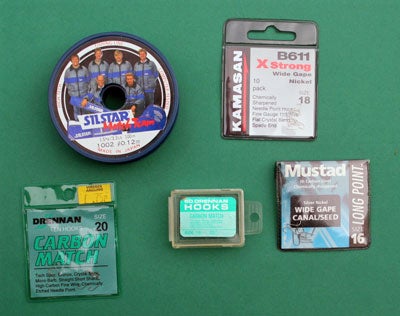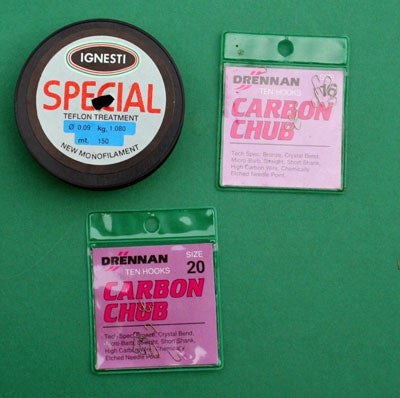| MARK WINTLE |
| Mark Wintle, an angler for thirty-five years, is on a quest to discover and bring to you the magic of fishing. Previously heavily involved with match fishing he now fishes for the sheer fun of it. With an open and enquiring mind, each week Mark will bring to you articles on fishing different rivers, different methods and what makes rivers, and occasionally stillwaters, tick. Add to this a mixed bag of articles on catching big fish; tackle design, angling politics and a few surprises. Are you stuck in a rut fishing the same swim every week? Do you dare to try something different and see a whole new world of angling open up? Yes? Then read Mark Wintle’s regular column. |
Hooklinks and Hooks for Light FloatfishingBEFORE ANYONE STARTS wondering when I’ll get to the knotless knot (usually for tying hair-rigs) let me make it clear this is about small hooks (up to 14) and light hooklinks for floatfishing.
There are several topics within this; hooklink materials, hooks that I use and can recommend, and tying them. Let’s start with hooklinks. Hooklinks For light floatfishing there can be distinct advantages in using a short hooklength of 18 – 24 inches that has a weaker breaking strain that the main line. The main one is that if you get snagged the stronger mainline will ensure that you only lose the hooklink. But it can also allow the use of a hooklink more likely to fool the fish through its increased suppleness, fineness, invisibility, or simply by helping the bait to behave more naturally. And it is therefore these qualities that we must seek for hooklink materials rather than those that make main lines better at their job. Not that long ago, perhaps fifteen years, we had one choice (no, I’m not going to hark back to hooks to gut, though I can just about remember seeing a packet of them in 1969) and that was hooks tied to regular nylon. For the past thirty years the first choice for fine line floatfishing has been spade-end hooks. This means that whatever hooklink material we choose it must be capable of being tied to a spade-end hook. With bigger eyed hooks it becomes much easier to use materials like braid. Silk whipped hooks ceased back in the sixties if my memory serves me right though the late Colin Dyson bravely attempted to trigger a revival in the 80s claiming that they were far superior to using spade-ends though the idea never caught on again. So the three choices for hooklinks for this type of fishing are regular nylon, co-polymer lines and fluorocarbon lines. Regular Nylon The old favourite, and many millions of hooks must have been tied to this, was surely Bayer Perlon. It’s certainly tough, and I was still using it in the early nineties when many of my match fishing colleagues (any old Team Castle members reading this?) had switched to Damyl Tectan. They reckoned that the extra high breaking strain allowed them to use far finer line than I was using. For comparison they were using 0.06mm (bs 1.1lbs) compared to Bayer of 0.10mm (also bs 1.1lbs). Because stiffness is related to thickness the line they were using was probably less than half as stiff as the one I was using, as well as being much finer and harder for the fish to see. And yet it was making far less difference to our respective results than ought to have been the case.
Eventually we concluded that other factors, ie, feeding and bait presentation were much more important than mere thickness/stiffness of the hooklink (we’ll come back to this with fluorocarbons). At that time I was not convinced of the reliability of Tectan, finding it brittle. I’d also given Drennan Double Strength a good trial and found that wanting too. But when Ignesti Special came along I finally made the switch to co-polymer lines. So, do regular lines still have a part to play for hooklinks? If you need a really tough hooklink and bait presentation is not affected then this is your answer. One situation that I came across many years ago in match fishing was fishing for eels. I’m only talking about small ones up to a pound or two and generally much less, but those tiny needle teeth can cut through soft nylons. Many expert pole anglers used Force or Racine Tortue for eels as these were really tough lines. I used to use the Racine in 2 When you purchase through links on our site, we may earn an affiliate commission, which supports our community.
|












